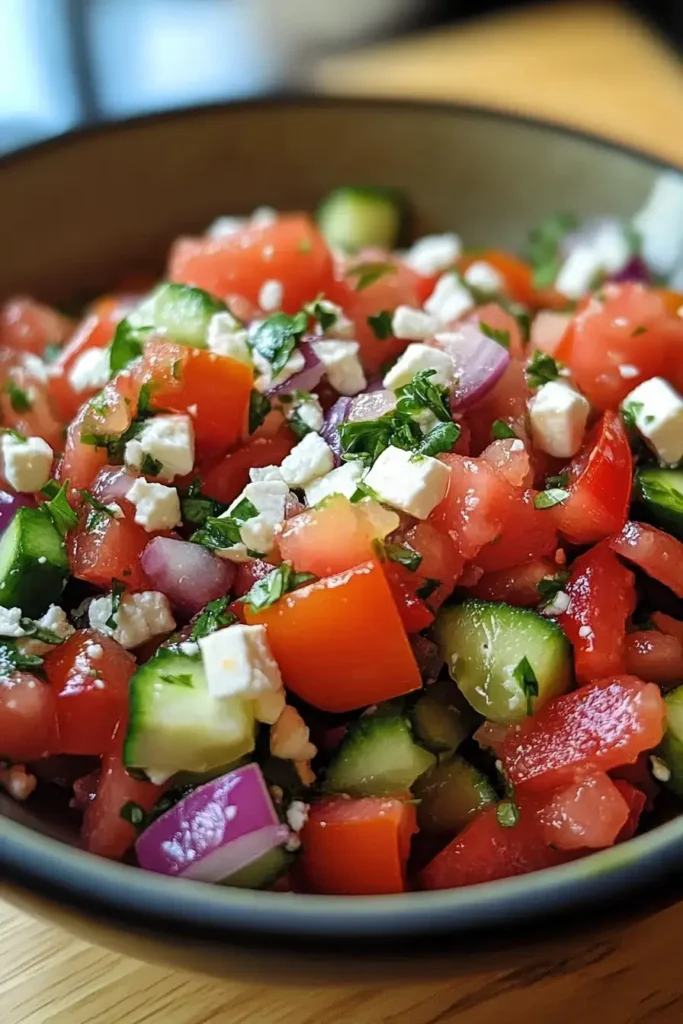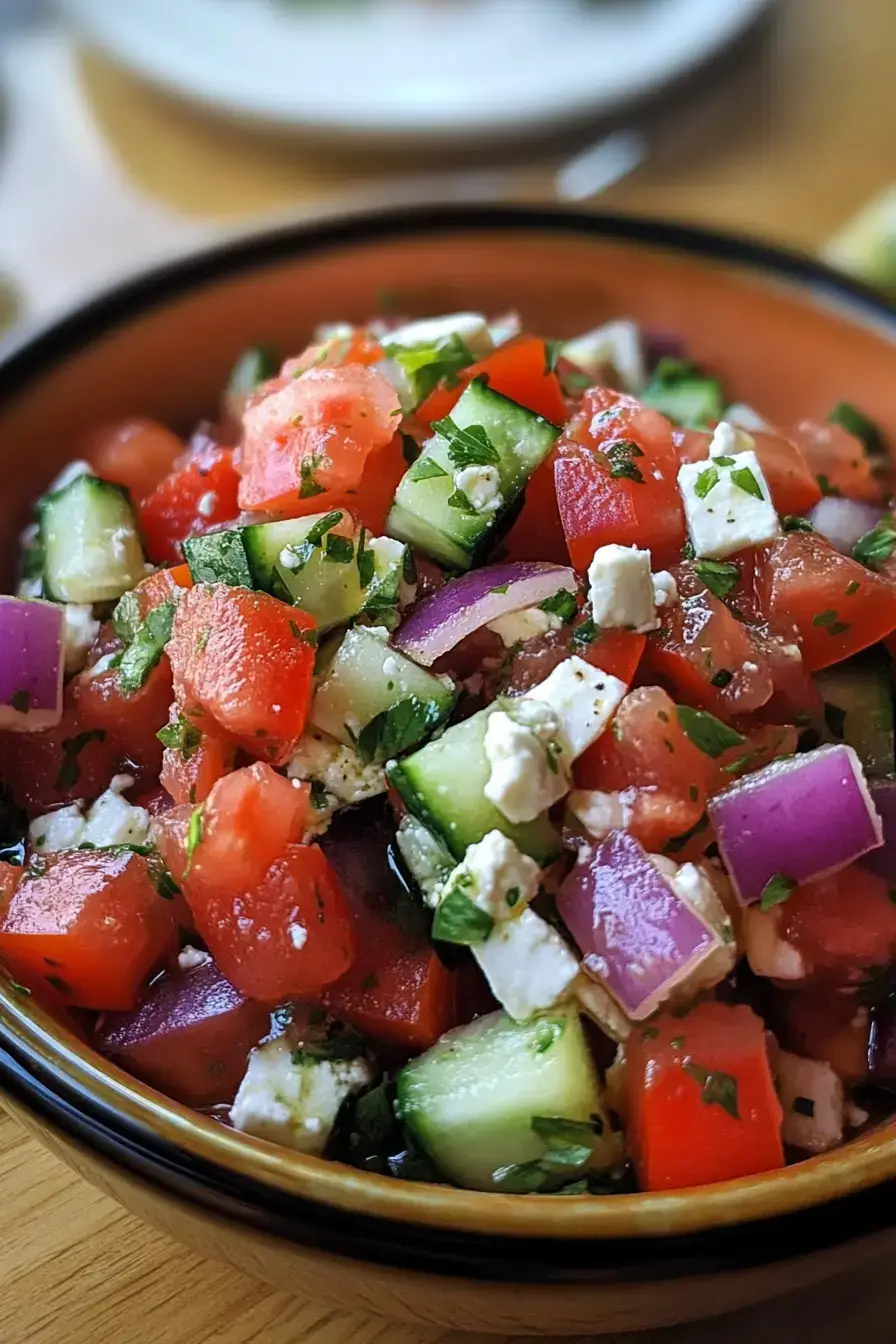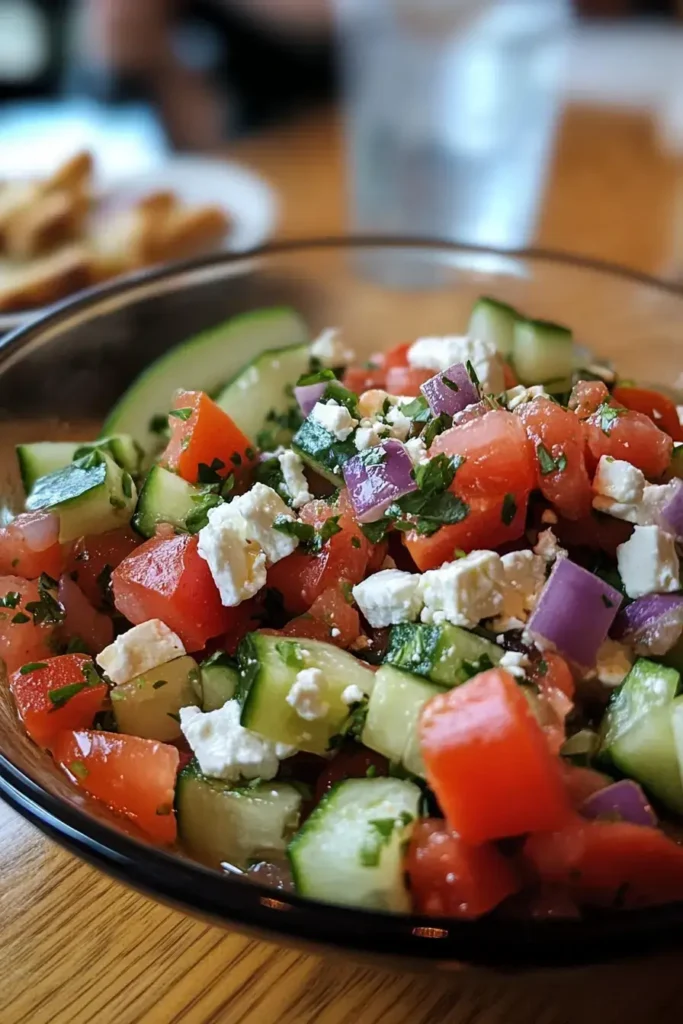Introduction
Why Greek Salsa Stands Out
Greek Salsa is a refreshing take on traditional salsa, blending the bold, fresh flavors of the Mediterranean with the convenience of a versatile dish. It’s the ideal recipe for those who love healthy, vibrant, and easy-to-make options. With fresh ingredients like tomatoes, cucumbers, olives, and feta cheese, this salsa not only tastes delicious but is also packed with nutrients.
The versatility of Greek Salsa makes it perfect for multiple occasions. Serve it with pita chips for a casual snack, use it as a topping for grilled chicken, or pair it with innovative recipes like these Loaded Baked Nachos with Guacamole to add a Mediterranean twist. It’s a crowd-pleaser that fits effortlessly into any menu.
A Mediterranean-Inspired Delight
Inspired by the simplicity and freshness of a traditional Greek salad, this salsa is a celebration of Mediterranean cuisine. The tangy bite of olives, the creaminess of feta cheese, and the crunch of cucumbers come together in perfect harmony. What sets Greek Salsa apart is its adaptability—it works just as well as a standalone dip as it does a vibrant topping for dishes like these Crack Chicken Tenders.
For an even more Mediterranean-themed spread, consider pairing this salsa with other recipes like the Roasted Cranberry Goat Cheese Flatbread. Together, they create a rich, flavor-packed experience that showcases the best of fresh, wholesome ingredients.
What You’ll Need
Essential Tools for Preparing Greek Salsa
To prepare Greek Salsa efficiently, having the right tools is crucial. This recipe is simple, but a few essential kitchen items can make the process smoother and ensure your salsa turns out perfectly. Start with a sharp chef’s knife—this will allow you to dice the vegetables with precision, maintaining their crisp texture and appearance. A sturdy cutting board is also necessary to provide a stable surface for chopping tomatoes, cucumbers, and onions.
Next, a mixing bowl is indispensable for combining the ingredients. Choose a large one to allow easy tossing and mixing, ensuring the flavors are evenly distributed. For measuring the quantities of olive oil, lemon juice, and seasonings, measuring cups and spoons are a must. These tools will help you achieve the right balance of flavors. Additionally, if you’re looking to elevate the presentation, serving your Greek Salsa in a decorative dish or bowl can make it even more appealing to your guests.
If you’re pairing this salsa with a Mediterranean-inspired menu, consider serving it alongside Caramelized Butternut Squash with Tangy Feta and Cranberry Drizzle for a cohesive theme that blends fresh and bold flavors.
Optional Equipment to Enhance Your Recipe
While the basic tools suffice, certain optional equipment can simplify the preparation and elevate your Greek Salsa experience. For instance, a food processor can be handy if you prefer a finer texture for your salsa. Simply pulse the ingredients a few times to achieve a consistency that’s more like a dip, making it perfect for pairing with Baked Chicken Taquitos.
A citrus juicer is another useful tool that helps extract every drop of juice from your lemons, enhancing the tangy flavor of the salsa. If you plan to make Greek Salsa regularly, investing in a set of airtight storage containers can help you keep your leftovers fresh for longer. This is especially useful if you want to make a larger batch to enjoy throughout the week.
Including this salsa in your meal plan? Pair it with Crockpot Steak Bites for a hearty yet fresh dinner idea that’s full of bold Mediterranean flavors.
Ingredients
Fresh Ingredients for a Flavorful Greek Salsa
The key to an unforgettable Greek Salsa lies in the freshness of its ingredients. Start with ripe, juicy tomatoes, as they serve as the base of the salsa, providing a natural sweetness and vibrant color. Pair these with crisp cucumbers to add a refreshing crunch, balancing the rich flavors of the other components. Red onions are another essential ingredient, offering a slightly sharp and sweet flavor that enhances the overall profile of the dish.
Kalamata olives, known for their briny taste, are a must-have for this recipe. They bring a bold Mediterranean touch, complemented perfectly by the creaminess of crumbled feta cheese. Fresh parsley adds a touch of herbal brightness, making the salsa feel light and invigorating. For the dressing, high-quality olive oil and freshly squeezed lemon juice are essential. These two ingredients tie everything together, adding richness and acidity to balance the flavors.
If you’re a fan of Mediterranean cuisine, these fresh ingredients are also perfect for recipes like Roasted Cranberry Goat Cheese Flatbread, offering a cohesive flavor experience across dishes.
Optional Additions and Substitutions
While the classic ingredients make for an authentic Greek Salsa, you can easily customize the recipe to suit your preferences. For example, if you enjoy a little heat, consider adding finely diced jalapeños or a sprinkle of red chili flakes. Want to make it vegan? Skip the feta cheese and substitute it with extra herbs like dill or mint for added freshness. You can also incorporate diced bell peppers for an additional layer of sweetness and crunch.
For those who love experimenting, try adding a handful of diced avocados to create a creamier texture. Alternatively, a splash of red wine vinegar can replace lemon juice for a slightly different tangy profile. These small changes allow you to adapt the recipe without losing its Mediterranean essence.
To explore other creative ideas, consider pairing your Greek Salsa with dishes like Baked Chicken Taquitos or Caramelized Butternut Squash for a well-rounded, flavor-packed menu.
Instructions
Preparing Your Ingredients the Right Way
To create the perfect Greek Salsa, start by preparing your ingredients with care. Begin by washing all your fresh produce thoroughly under cold running water. This step is essential to remove any dirt or impurities and ensures the vibrant flavors of the vegetables shine through. Next, dice your tomatoes into small, even pieces. Aim for a size that will blend well with the other ingredients without overpowering them.
Move on to the cucumbers, which should be peeled if you prefer a softer texture, though keeping the peel adds extra crunch and nutrients. Dice them into similar-sized pieces as the tomatoes. For the red onions, a fine dice works best to distribute their sharp flavor evenly throughout the salsa. If the onions taste too strong, soak them briefly in water to mellow their flavor.
For an enhanced Mediterranean touch, slice Kalamata olives into thin rounds and crumble your feta cheese into small, manageable chunks. If you’re inspired by Mediterranean dishes, these preparation techniques can also be used in recipes like Cabbage Roll Casserole for added texture and flavor balance.
Mixing and Assembling the Greek Salsa
Once your ingredients are prepped, it’s time to assemble your Greek Salsa. Take a large mixing bowl and combine the diced tomatoes, cucumbers, and onions. Add the sliced olives and crumbled feta cheese to the mix, ensuring the ingredients are evenly distributed. Drizzle high-quality olive oil and freshly squeezed lemon juice over the vegetables. These two ingredients act as the dressing, tying the flavors together beautifully.
To elevate the taste further, add minced garlic for a subtle kick and sprinkle freshly chopped parsley over the mixture. Season the salsa with salt and black pepper to taste, keeping in mind that the olives and feta are already salty. Gently toss the ingredients with a large spoon, ensuring the dressing coats every piece without breaking up the vegetables.
For a complete Mediterranean meal, consider serving this Greek Salsa alongside Crockpot Steak Bites or using it as a topping for Loaded Baked Nachos to add a fresh and tangy twist.
Serving and Final Touches
Once your Greek Salsa is fully mixed, transfer it to a serving dish. If you want to impress your guests, garnish the top with a few whole olives and a sprinkle of crumbled feta. For the best flavor, let the salsa sit for about 15 minutes before serving. This resting period allows the dressing to soak into the vegetables, enhancing the overall taste.
Serve the salsa chilled with warm pita bread, tortilla chips, or as a topping for grilled fish or chicken. It pairs particularly well with recipes like Caramelized Butternut Squash, offering a harmonious blend of sweet and savory flavors. Store leftovers in an airtight container in the refrigerator for up to two days.
Nutrition Score
Health Benefits of Greek Salsa
Greek Salsa is not only a flavorful addition to your table but also a nutritious choice packed with essential vitamins and minerals. Tomatoes, the base ingredient of this recipe, are an excellent source of antioxidants such as lycopene, which is known to reduce the risk of chronic diseases. Additionally, they are rich in vitamin C, boosting your immune system and promoting healthy skin.
Cucumbers contribute to hydration, as they are primarily made of water. They also contain important nutrients like vitamin K, which supports bone health. Red onions, another key ingredient, are loaded with antioxidants and compounds that promote heart health. When combined, these fresh vegetables make Greek Salsa a guilt-free, nutrient-packed option for snacking or mealtime.
To further enhance your healthy eating, pair this Greek Salsa with lighter dishes like Honey Garlic Shrimp for a balanced and satisfying meal.
Calorie Count and Macronutrients
Each serving of Greek Salsa is low in calories, making it an excellent choice for those watching their intake. On average, a serving contains approximately 120 calories, primarily from the olive oil and feta cheese. It includes around 9 grams of healthy fats, which support brain and heart health, and 3 grams of protein, mainly from the feta cheese.
Carbohydrates are minimal in this recipe, with about 4 grams per serving, mostly derived from the fresh vegetables. This low-carb profile makes it an ideal dish for ketogenic or low-carb diets. The olive oil used in the recipe is a rich source of monounsaturated fats, known to support cardiovascular health and reduce inflammation.
For more nutrient-dense recipes, try pairing Greek Salsa with a dish like Stuffed Potato Cakes to create a wholesome, well-rounded meal.
Why Greek Salsa is a Healthy Choice
One of the standout features of Greek Salsa is its balance of macronutrients and micronutrients. The fresh ingredients provide essential vitamins, minerals, and antioxidants without adding unnecessary calories or processed fats. This makes it a perfect option for health-conscious individuals who want to enjoy a flavorful dish without compromising on nutrition.
For an even more health-focused meal plan, consider incorporating Greek Salsa into your dishes as a topping or side. It pairs beautifully with recipes like Cabbage Roll Casserole to add a burst of freshness and extra nutrients to hearty meals.
Serving & Storage
How to Serve Greek Salsa
Greek Salsa is an incredibly versatile dish that can be served in various ways to suit different occasions. For a casual gathering, pair it with warm pita bread, tortilla chips, or vegetable sticks like carrots and celery. The fresh, tangy flavors make it an excellent appetizer that is both light and satisfying. It’s also a wonderful topping for grilled meats, particularly chicken or fish, adding a Mediterranean twist to your meals.
For a more creative presentation, spoon Greek Salsa over baked potatoes or stuffed bell peppers for a quick and delicious side dish. If you’re hosting a dinner party, consider incorporating it into your main course by serving it alongside dishes like Crack Chicken Tenders for a perfect balance of flavors and textures. The salsa’s bold, fresh ingredients complement hearty proteins beautifully, making it a go-to addition for any meal.
To add an innovative twist, serve Greek Salsa as a topping for Loaded Baked Nachos, transforming this classic snack into a Mediterranean-inspired delight that your guests will love.
Storing and Reheating Tips
Proper storage is essential for maintaining the freshness and flavor of Greek Salsa. To store leftovers, transfer the salsa to an airtight container and refrigerate it promptly. The salsa will stay fresh for up to two days when stored correctly, though it is best enjoyed on the day it is made. Before serving leftovers, give the salsa a gentle toss to redistribute the dressing and juices evenly.
If you plan to prepare Greek Salsa ahead of time, keep the chopped vegetables and dressing separate until just before serving. This prevents the ingredients from becoming soggy and ensures the flavors remain vibrant. While Greek Salsa doesn’t require reheating, it can be served slightly chilled for the best flavor experience.
For meal prep enthusiasts, Greek Salsa can also be used as a fresh component in other dishes. Pair it with recipes like Crockpot Steak Bites to add a refreshing element to your weekly meal plan.
Creative Ways to Customize Greek Salsa
Spicy Greek Salsa for a Flavorful Kick
If you enjoy a bit of heat, consider turning your Greek Salsa into a spicy sensation. Adding finely diced jalapeños or serrano peppers can elevate the flavor profile without overpowering the dish’s fresh Mediterranean essence. For an even more intense heat, a pinch of red chili flakes or a splash of hot sauce can be incorporated into the dressing. The spicy elements pair exceptionally well with the briny olives and creamy feta, creating a balanced yet bold flavor.
Spicy Greek Salsa is perfect for pairing with hearty dishes like Stuffed Potato Cakes, as the heat from the salsa complements the rich, cheesy filling. You can also use it as a topping for grilled shrimp or chicken to add a vibrant, fiery twist to your meal.
Fruit-Infused Greek Salsa
For those who prefer a sweet twist, fruit-infused Greek Salsa is a fantastic variation. Adding diced fruits like watermelon, pineapple, or mango introduces a refreshing sweetness that balances the dish’s savory components. The juicy fruits blend beautifully with the crunch of cucumbers and the tanginess of the feta cheese. This version works wonderfully as a side dish for summer barbecues or as a topping for fish tacos.
If you’re hosting a festive gathering, pair fruit-infused Greek Salsa with recipes like Baked Cranberry Cream Cheese Dip for a creative and colorful appetizer spread. The blend of sweet and savory flavors is sure to impress your guests.

FAQs
What is a traditional Greek salad made of?
A traditional Greek salad, or “Horiatiki,” is a simple yet flavorful dish that features fresh vegetables and authentic Mediterranean ingredients. The main components include ripe tomatoes, crisp cucumbers, and red onions, all diced into bite-sized pieces. Kalamata olives and crumbled feta cheese are added to provide the distinctive tangy and salty flavors that Greek cuisine is known for. The salad is usually dressed with a generous drizzle of olive oil, a splash of red wine vinegar, and a sprinkle of dried oregano to bring the flavors together.
Greek Salsa borrows these elements and transforms them into a chunky dip or topping, making it more versatile while retaining its Mediterranean essence. Like the salad, it pairs beautifully with dishes like Crockpot Steak Bites or Caramelized Butternut Squash for a well-rounded meal.
What is salsa called?
The term “salsa” originates from the Spanish word for “sauce.” Traditionally, it refers to a mixture of vegetables, herbs, and seasonings served raw or cooked, often as a condiment or dip. While salsa is commonly associated with Mexican cuisine, it has been adapted globally to reflect regional flavors and ingredients. Greek Salsa, for example, is a Mediterranean-inspired version that swaps the traditional tomatoes and chilies for ingredients like cucumbers, olives, and feta cheese.
Greek Salsa isn’t just a dip—it’s a versatile addition to meals. Use it as a topping for dishes like Loaded Baked Nachos to bring a fresh, Mediterranean twist to a classic snack. Its chunky texture and bold flavors make it a standout, whether used as a dip or incorporated into main dishes.
How to can salsa in a Mason jar?
Canning salsa, including Greek Salsa, requires careful preparation to preserve its freshness and flavor. Start by sterilizing your Mason jars and lids to ensure a clean, safe environment for the salsa. Prepare the Greek Salsa as directed, but for canning purposes, ensure the mixture is cooked briefly to enhance its shelf life. Fill the jars with the warm salsa, leaving about 1 inch of headspace to allow for expansion. Secure the lids tightly and process the jars in a hot water bath for 10–15 minutes, depending on your altitude.
Once sealed, let the jars cool completely before storing them in a cool, dark place. When properly canned, salsa can last up to a year. If you’re planning a meal with preserved salsa, try pairing it with recipes like Baked Chicken Taquitos for a quick and flavorful snack.
Conclusion
Why You’ll Love Greek Salsa
Greek Salsa is more than just a dish; it’s a versatile and flavorful addition to your culinary repertoire. Its fresh ingredients, inspired by the simplicity of Mediterranean cuisine, make it a perfect choice for those who love healthy and vibrant flavors. Whether you’re preparing it for a casual snack, a party appetizer, or a topping for grilled dishes, Greek Salsa effortlessly elevates any meal.
What sets this recipe apart is its adaptability. You can serve it as a dip with warm pita bread, pair it with dishes like Crack Chicken Tenders, or even use it to enhance classic recipes like Loaded Baked Nachos. No matter how you choose to enjoy it, Greek Salsa brings a burst of freshness and bold flavors to your table.


